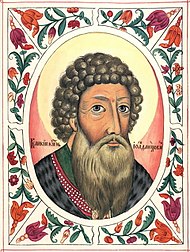Ivan Danilovich
| Ivan I | |
|---|---|
 |
|
| Grand Duke of Moscow | |
| Reign | 21 November 1325 – 31 March 1340 or 1341 |
| Predecessor | Yury |
| Successor | Simeon I |
| Born | c. 1288 Moscow, Grand Duchy of Moscow |
| Died | 31 March 1340 or 1341 (aged 51–53) Moscow, Grand Duchy of Moscow |
| Burial | Cathedral of the Archangel |
| Consort | Elena Aleksandra |
| Issue |
Simeon Ivanovich Daniil Ivanovich Fefinia Ivanovna Maria Ivanovna Ivan Ivanovich Andrei Ivanovich Eudoxia Ivanovna Fedosia Ivanovna Maria Ivanovna |
| Dynasty | Rurik |
| Father | Daniel |
| Mother | Maria |
| Religion | Russian Orthodox Church |
Ivan I Daniilovich Kalita (Russian: Ива́н I Дании́лович Калита́; 1288 – 31 March 1340 or 1341) was Grand Duke of Moscow from 1325 and Vladimir from 1332.
Ivan was the son of the Prince of Moscow Daniil Aleksandrovich.
After the death of his elder brother Yury, Ivan inherited the Principality of Moscow. Ivan participated in the struggle to get the title of Grand Duke of Vladimir which could be obtained with the approval of a khan of the Golden Horde. The main rivals of the princes of Moscow in this struggle were the princes of Tver – Mikhail, Dmitry the Terrible Eyes, and Alexander II, all of whom obtained the title of Grand Duke of Vladimir and were deprived of it. All of them were murdered in the Golden Horde. In 1328 Ivan Kalita received the approval of khan Muhammad Ozbeg to become the Grand Duke of Vladimir with the right to collect taxes from all Russian lands.
According to the Russian historian Kluchevsky, the rise of Moscow under Ivan I Kalita was determined by three factors. The first one was that the Moscow principality was situated in the middle of other Russian principalities; thus, it was protected from any invasions from the East and from the West. Compared to its neighbors, Ryazan principality and Tver principality, Moscow was less often devastated. The relative safety of the Moscow region resulted in the second factor of the rise of Moscow – an influx of working and tax-paying people who were tired of constant raids and who actively relocated to Moscow from other Russian regions. The third factor was a trade route from Novgorod to the Volga river.
...
Wikipedia
